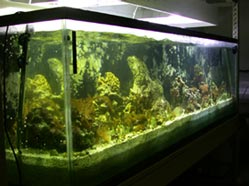News Archives - 1999
Corals, sponges, algae teach biodiversity up close
 The two aquaria in Science Hall 225, illuminated by 6500K metal halide lights and bubbling with water-surges every 40 seconds, have dramatically changed the teaching of biological diversity and ecology at Augsburg.
The two aquaria in Science Hall 225, illuminated by 6500K metal halide lights and bubbling with water-surges every 40 seconds, have dramatically changed the teaching of biological diversity and ecology at Augsburg.
Building a coral reef
Over the past four years, biology Professor William Capman has developed a state-of-the-art coral reef aquarium setup that houses a thriving, complex, miniature ecosystem. In contrast to more typical "holding tanks" supporting organisms for limited periods, the aquaria, unique among Minnesota colleges, allow students to "see organisms doing what they do in their ordinary lives, interacting and behaving normally over months and years," says Capman.
The two interconnected tanks, with 130 gallons of seawater, house well over 100 species of organisms unique to marine habitats, including corals, tunicates, sponges and "seaweeds" - many are quite unlike anything a Midwesterner is otherwise likely to encounter. Capman constructed a coral reef habitat by building a rock structure on a PVC pipe framework in one tank, while in the other he set up a sea grass environment. He carefully researched and planned the assortment of species for their roles in maintaining the thriving ecosystem or for their value in teaching. The "algae turf scrubber" filtering the water is based on designs developed at the Smithsonian Institution.
Field research and lab study
The combination of field study during an Interim course taught in the Florida Keys every other year and the aquaria gives Augsburg students special opportunities for study of marine biology. During the intensive three-week Interim course, field observations and research while snorkeling at the reef or wading in seagrass and mangrove habitats present an almost overwhelming assortment of plants and animals. Back home in the lab, observation can be detailed and extended. Under a microscope, for example, students can observe the growth patterns of stony corals, long thought impossible to grow in captivity, and view symbiotic algae within the living, coral colonies. "These are experiences few professional biologists have had," says Capman.
Inspiring students' appreciation for biodiversity will help them understand the need to protect natural habitats, says Capman. Increasingly during this year he has noticed students spending time around the tanks, watching such activities as the brittle stars feeding or the elaborate courtship of the bicolor blennies. "You have to wait, be patient and observe closely," he advises.
Benefits to other biology courses
The aquarium setup impacts teaching throughout the department. Associate Professor Esther McLaughlin has incorporated study of the reef inhabitants into her plant biology and invertebrate zoology courses. "Seeing live sponges, polychaetes, corals, brittle stars and chitonsis is not a fancy add-on - it's what inverts are," she says.
David McLaughlin, a plant biology professor at the University of Minnesota, also benefits from Augsburg's aquaria by borrowing specimens for teaching. "It's about the best collection of the large marine green algae I have seen in 30 years of teaching ... then there are the red algae, the diatoms ... there are all kinds of things - it's a spectacular source of algal diversity," he says.
After four years of experimentation, a 20-gallon tank trial run, setbacks and gradual accumulation of costly equipment and organisms, the reef tanks "are now thriving and living up to their potential," says Capman. Last year students began helping to prepare interpretive materials to aid in teaching.
Using funds from donor gifts, the biology department plans to begin a substantial expansion of the setup to enhance faculty and student research.